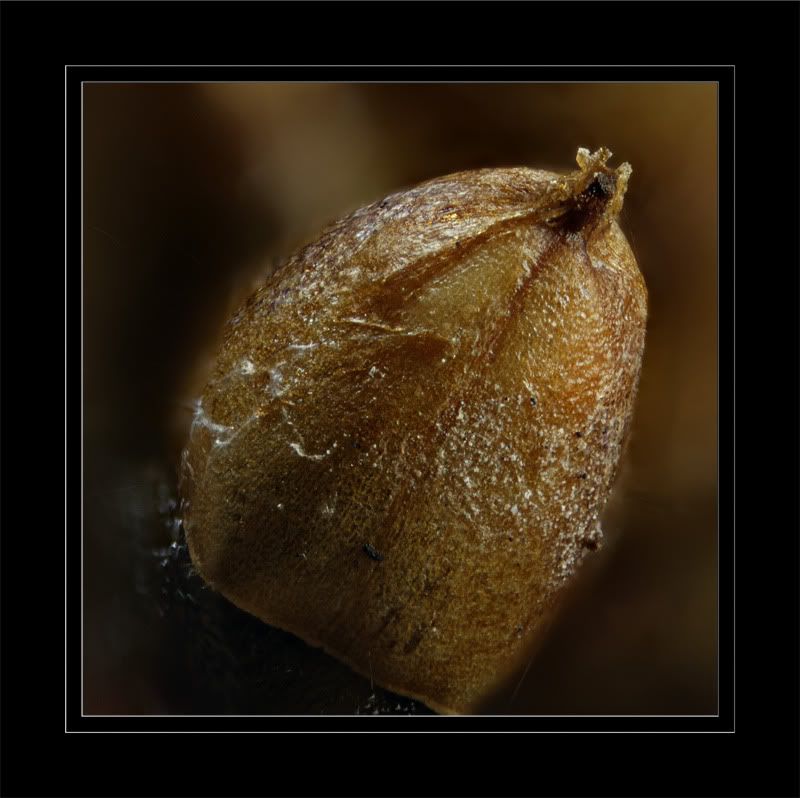Bellows extension varied from 170mm to 130mm.

p.s. I've been searching for the thread that says how to calculate the focal length and effective fstop for these objectives, but haven't found it yet.
Here's the objective mounted:

Moderators: rjlittlefield, ChrisR, Chris S., Pau


Both relationships are correct but the two f-number's mean slightly different things.Charles Krebs wrote:Somewhere in a thread Rik gave a relationship with an additional term.
That's in the plan, but I'm using the outer cylinder to hold an annulus blocking the light leaksCharles Krebs wrote:See this pdf for some info:
http://krebsmicro.com/mplan.pdf
Focal length is 21.19mm
And you would triple your working distance (up to 9mm from 3mm) if you removed the outer "BD" cylinder.
So far, I've just been moving the camera. I haven't attached the lens to the lead screw yet.Charles Krebs wrote: Are you shifting camera and lens together as a unit or keeping lens in same place and just moving camera body around? (The "quality" image circle on these is not really large enough to move just the camera body).
Thanks, those were the numbers I needed. Now my spreadsheet, http://www.photomacrography.net/forum/v ... php?t=8054 , doesn't give me quite the expected numbers:Charles Krebs wrote: Your "f-number" would be about 2. Typically you see the relationship as:
f-number = 1/(2*NA)
Somewhere in a thread Rik gave a relationship with an additional term:
f-number = 1/(2*NA) * (m/(m+1))
--- which would work out to f1.8 if used at 10X
Won't this give me a circular reference since I'm calculating the magnification from the object distance and DOF which use the fstop?rjlittlefield wrote: 1/(2*NA) is the effective f-number (working f-number) with respect to the subject. This is a concept that does not often occur in photography. The corresponding effective f-number with respect to the camera is simply m times larger, or m*(1/(2*NA)) = m/(2*NA).
1/(2*NA) * (m/(m+1)) is the nominal f-number that would have to be set on the aperture ring of an ordinary lens used at the same magnification.* Of course the effective f-number of an extended lens is just m+1 times its nominal f-number, so again the effective f-number with respect to the camera is m*(1/(2*NA)) = m/(2*NA).
If you want to think in terms of effective f-number with respect to the camera, the easiest way is to just use these formulas:
f_effective_at_camera = m/(2*NA) for a microscope objective, and
f_effective_at_camera = f_aperture_ring*(m+1) for an ordinary lens.
In the formula that 1/f = 1/o + 1/i, the distances o and i are measured from focal plane to a "principal plane" of the lens. But the principal plane of a lens is seldom located at the shoulder of the mounting threads, so you need to deal with the offset. For your purposes and this lens, the offset is 23.09 and the appropriate Extension is 233.09, giving an object distance of 23.309 and magnification = 10.elf wrote:Now my spreadsheet, http://www.photomacrography.net/forum/v ... php?t=8054 , doesn't give me quite the expected numbers:
I expected the magnification to be 10.0 at 210mm extension.
- Focal Length=21.19
F stop=1.8
Extension=210.020668
Magnification=8.911310
ObjectDistance=23.567877
DOF=0.003966
I guess your spreadsheet is set up to use f_aperture_ring as a basic input. In that case, ignore my comment, or better yet, remember it for possible use in the future.elf wrote:Won't this give me a circular reference since I'm calculating the magnification from the object distance and DOF which use the fstop?rjlittlefield wrote: 1/(2*NA) is the effective f-number (working f-number) with respect to the subject. This is a concept that does not often occur in photography. The corresponding effective f-number with respect to the camera is simply m times larger, or m*(1/(2*NA)) = m/(2*NA).
1/(2*NA) * (m/(m+1)) is the nominal f-number that would have to be set on the aperture ring of an ordinary lens used at the same magnification.* Of course the effective f-number of an extended lens is just m+1 times its nominal f-number, so again the effective f-number with respect to the camera is m*(1/(2*NA)) = m/(2*NA).
If you want to think in terms of effective f-number with respect to the camera, the easiest way is to just use these formulas:
f_effective_at_camera = m/(2*NA) for a microscope objective, and
f_effective_at_camera = f_aperture_ring*(m+1) for an ordinary lens.
That indeed is the source of the error. My spreadsheet now agrees with the observed behaviour.rjlittlefield wrote: In the formula that 1/f = 1/o + 1/i, the distances o and i are measured from focal plane to a "principal plane" of the lens. But the principal plane of a lens is seldom located at the shoulder of the mounting threads, so you need to deal with the offset. For your purposes and this lens, the offset is 23.09 and the appropriate Extension is 233.09, giving an object distance of 23.309 and magnification = 10.
The main reason is the lens remains in a fixed position and this allows doing parallax free panoramas. If you rotate the camera and lens around the entrance pupil, there is no limit to the FOV vertically or horizontally. If you shift the camera left/right/up/down, you'll be limited by the image circle but even for larger magnifications, this should give you 3 or 4 times the FOV.AndrewC wrote:Can you remind me again why you use "draw" to adjust the plane of focus rather than moving the camera or subject ?
Andrew